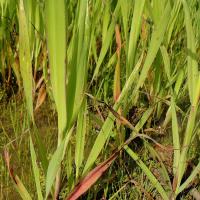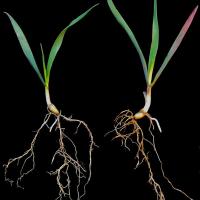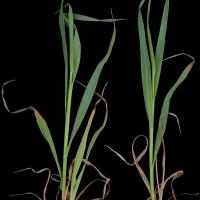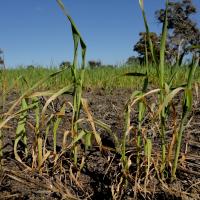Diagnosing waterlogging and salinity in oats
Waterlogging and salinity often occur together. Oats are very waterlogging tolerant but are more susceptible to salinity damage than wheat and barley.
What to look for
- Poor germination or pale plants, in water collecting areas, particularly on shallow duplex soils.
- Wet soil and/or water-loving weeds or salt tolerant plants only as salinity increases.
- Nitrogen deficient plants with more leaf necrosis and premature death in more saline areas.
Paddock
- Waterlogging symptoms
- Plants are particularly vulnerable from seeding to tillering with seminal roots being more affected than later forming nodal roots. Waterlogged seed will be swollen and may have burst.
- Seedlings may die before emergence or be pale and weak.
- Waterlogged plants appear to be nitrogen deficient with pale plants, poor tillering, and older leaf death If waterlogging persists, roots (particularly root tips) cease growing, become brown and then die.
- Seminal roots are important for accessing deep subsoil moisture. If damaged by waterlogging the plants may be more sensitive to spring drought.
Plant
- Salinity symptoms
- Plants have a harsh droughted appearance, and may be smaller with smaller dull leaves.
- Old leaves develop dull yellow tips and die back from the tips and edge.
- Premature death.
Plant
What else could it be
| Condition | Similarities | Differences |
|---|---|---|
| Diagnosing nitrogen deficiency in oats | Similar foliar symptoms | No root browning and less old leaf necrosis and symptoms are not confined to wet or saline areas. |
Where does it occur?
- Waterlogging occurs when there is insufficient oxygen in the soil pore space for plant roots to adequately respire.
- Root harming gases such as carbon dioxide and ethylene also accumulate in the root zone and affect the plants.
- Waterlogging damage is worse in the following situations
- Deeper sown crops
- Water accumulating or poorly drained areas such as valleys, at the change of slope or below rocks Duplex soils, particularly sandy duplexes with less than 30 cm sand over clay
- Low nitrogen status crops
- In very warm conditions when oxygen is more rapidly depleted in the soil
- Salinity affects growth by reducing plant root ability to extract water from the soil, and chloride toxicity.
- Primary salinity occurs naturally in heavy textured, highly alkaline and usually well-drained soils with high levels of salt in the subsoil. Most common are morrell-blackbutt loams on the edge of major valleys or greenstone soil and Dowak clay in the Esperance mallee. Oats yield poorly on these soils.
- Secondary salinity has been caused by salt accumulation from saline watertables or seepages that have increased after land clearing.
- Salinity is frequently accompanied by waterlogging in autumn and winter, which greatly increases plant damage.
Management strategies
- Avoid sowing on saline areas.
- Sow as early as possible with a higher seeding rate.
- Drainage may be appropriate on sandy duplex soils on sloping sites.
How can it be monitored?
- Water levels can be monitored with bores or observation pits, but watertables can vary greatly over short distances.
- Plants can be waterlogged there is a watertable within 30 cm of the surface and no indication of waterlogging at the surface. Observe plant symptoms and paddock clues and verify by digging a hole.
See also
Page last updated: Tuesday, 6 September 2016 - 9:40am





